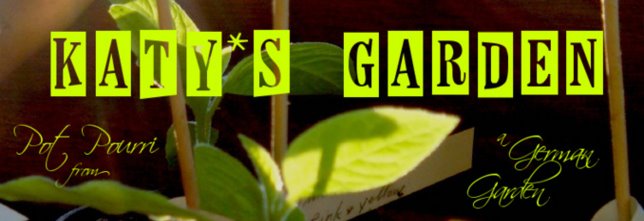
Today I transplanted my tiny "Pam's Choice" foxgloves into single 200 ml pots.
Yesterday I had a long walk in the woods that surround our tiny village, all the way to the romantic ruins ofthe Waldeck castle. The woods (and the ruins) are full of interesting plants: honesty, solomon's seal, hart's tongue, sweet woodruff, imposing male ferns, and beautiful blue campanulas... but it's the wild foxgloves that stole my heart.
Some are scrawny objects, half starved and little more than worthless weeds, but many are tall majestic plants, blooming almost all the way around the stem. They like woodland but are more happy in a sunny clearing. A plant for halfshade, no more. There are pink-mauve ones, intense magenta ones, some almost purple, and even one pure white, with the faintest blond markings in the throat. Some have purplish flowers on the lower part of the stem, but the upper, newer flowers are creamy greenish. I marked the white one. I hope to find it again and collect the seeds.
The stinking hellebores, Helleborus foetidus, that made such a lovely show in the woods in february and march, when all was dreary brown, are in seed now. I picked a handful of seed heads; I always liked hellebores, and this one is, I think, one of the most interesting. I love green flowers, but this species also has a beautiful foliage, very dark green, narrow, finely serrated, enourmously more elegant than any of the common garden hellebores. This is very fortunate, since three or more years may pass before the seedlings can bloom.
Yesterday I had a long walk in the woods that surround our tiny village, all the way to the romantic ruins ofthe Waldeck castle. The woods (and the ruins) are full of interesting plants: honesty, solomon's seal, hart's tongue, sweet woodruff, imposing male ferns, and beautiful blue campanulas... but it's the wild foxgloves that stole my heart.
Some are scrawny objects, half starved and little more than worthless weeds, but many are tall majestic plants, blooming almost all the way around the stem. They like woodland but are more happy in a sunny clearing. A plant for halfshade, no more. There are pink-mauve ones, intense magenta ones, some almost purple, and even one pure white, with the faintest blond markings in the throat. Some have purplish flowers on the lower part of the stem, but the upper, newer flowers are creamy greenish. I marked the white one. I hope to find it again and collect the seeds.
The stinking hellebores, Helleborus foetidus, that made such a lovely show in the woods in february and march, when all was dreary brown, are in seed now. I picked a handful of seed heads; I always liked hellebores, and this one is, I think, one of the most interesting. I love green flowers, but this species also has a beautiful foliage, very dark green, narrow, finely serrated, enourmously more elegant than any of the common garden hellebores. This is very fortunate, since three or more years may pass before the seedlings can bloom.


No comments:
Post a Comment